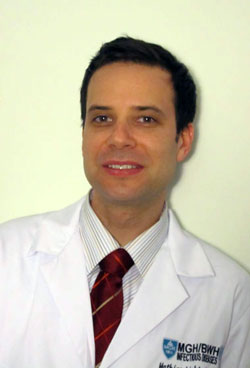 Dr. Robert SilicianoA key obstacle to an AIDS cure is the latent reservoir of virus that persists in memory CD4+ T cells and is impervious to standard anti-HIV drugs. It has been a target of numerous research teams—many supported by amfAR. Two such recent studies shed new light on the issue, and offer potential solutions.
Dr. Robert SilicianoA key obstacle to an AIDS cure is the latent reservoir of virus that persists in memory CD4+ T cells and is impervious to standard anti-HIV drugs. It has been a target of numerous research teams—many supported by amfAR. Two such recent studies shed new light on the issue, and offer potential solutions.
First, to evaluate the magnitude of the task at hand, amfAR-funded scientist Dr. Robert Siliciano of Johns Hopkins University—working with colleagues at Harvard and Columbia Universities, and ETH Zürich in Switzerland—examined data from patient studies and test tube models of drugs being tested as “latency-reversing agents.” Such interventions are designed to purge T cell reservoirs of latent HIV. Writing in the September issue of the Proceedings of the National Academy of Sciences, they sought to quantify the degree of reservoir suppression that might need to be obtained to effect a cure.
Their calculations, derived from a mathematical model they developed to predict HIV treatment outcomes, suggest this will be a major technological challenge. Based on the time between elimination of all detectable virus and its reappearance weeks to years later in recent transplant patients, the Mississippi child, and others, a 2000-fold decrease in reservoir size will be needed to stave off virus return for one year off antiretroviral medications. And a 10,000-fold decrease will be required to stop viral rebound altogether, thereby permitting potential cures.
 Dr. Mathias LichterfeldHow realistic is this? amfAR grantee Dr. Mathias Lichterfeld of Harvard University, with associates from China Medical University in Shenyang, Penn State University, the University of Delaware, the Howard Hughes Medical Institute, ICREA and the IrsiCaixa Institute for AIDS Research in Spain, and the Institute of Microbiology of the University Hospital Center in Switzerland, sought such an answer by evaluating the long-term effects of early HIV treatment initiation. The researchers compared the reservoir sizes of nine HIV-positive individuals who started antiretroviral therapy (ART) during acute infection and remained on treatment for at least 10 years to patients with similar treatment durations, but who began ART much later after infection.
Dr. Mathias LichterfeldHow realistic is this? amfAR grantee Dr. Mathias Lichterfeld of Harvard University, with associates from China Medical University in Shenyang, Penn State University, the University of Delaware, the Howard Hughes Medical Institute, ICREA and the IrsiCaixa Institute for AIDS Research in Spain, and the Institute of Microbiology of the University Hospital Center in Switzerland, sought such an answer by evaluating the long-term effects of early HIV treatment initiation. The researchers compared the reservoir sizes of nine HIV-positive individuals who started antiretroviral therapy (ART) during acute infection and remained on treatment for at least 10 years to patients with similar treatment durations, but who began ART much later after infection.
Writing in the Journal of Virology, they report that for both groups the decline in latent virus among memory CD4+ T cells occurred within the first three to four years of drug therapy, but was more rapid and of greater magnitude in those receiving prompt viral suppression. Despite smaller reservoir sizes, these individuals were not cured after long-term antiretroviral treatment. Dr. Lichterfeld’s study confirms other reports that, regardless of how quickly treatment is started and its duration, ART alone is “unlikely to lead to viral eradication.”
The authors conclude that while long-term ART initiated during early infection cannot eliminate HIV, the resultant “low viral reservoirs…may make such patients good candidates for future interventional studies aiming at HIV-1 eradication and cure.”
Dr. Laurence is amfAR’s senior scientific consultant.